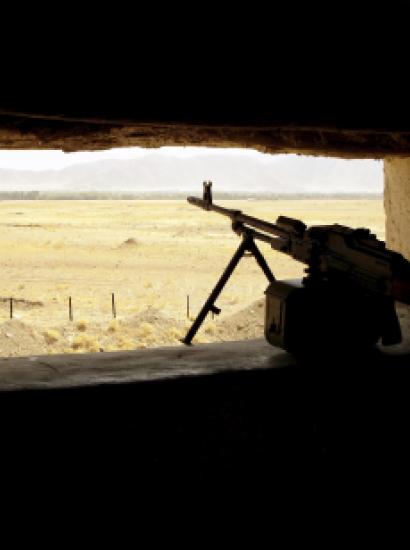- History
Editor’s note: This essay is an excerpt of the Hoover Press book America and the Future of War.
Over the past half century, American political and military leaders have attempted to make war less costly in human terms. As far as lowering American casualties in combat, that is a wholly worthwhile endeavor. But that effort has carried over into the creation of unrealistic rules of engagement governing the use of weapons and representing efforts to reduce civilian casualties. To a certain extent, this has driven the revolution in precision munitions. In the Gulf War of 1991, extensive interviews with Iraqi prisoners of war indicated that the coalition aircraft they most feared was the ancient—even at that time—B-52. Above all, they emphasized the terrifying shock that strikes carried out miles away had on their perspective of the war and morale.
Ironically, because the B-52 computers were misaligned, the heavy bombers never hit their targets at which they were aiming. It did not matter, because the impact of the B-52 strikes was largely on the morale of Iraqi soldiers hunkered down in the deserts of Kuwait and southern Iraq. The horrendous noise and shaking of the earth from strikes even a dozen miles distant affected them deeply. Ironically, in the bombing of ISIS, including its military forces and encampments in the desert, US military and political leaders have not been willing to use the B-52. The reason behind this unwillingness lies in a belief among the political leadership in Washington that precision strikes prevent all collateral damage, which they do not. Such beliefs entirely miss the purpose of the use of military force and air power in particular, which is to wreck the enemy’s morale as much as to achieve physical damage and kill his soldiers.
The emphasis on technology is not surprising, given that it has been one of the strengths of American society for more than a century. Yet, there are limits to what technology can achieve by itself, while the enemy will always get a vote, and the more sophisticated and competent he is, the more likely that he will seek out and discover means to disrupt and distort our technological capabilities. In the conflicts that spun out of the global war on terrorism, the United States has enjoyed a massive superiority in weapons and the technology of those systems over the capabilities of its opponents. Nevertheless, one should not forget that even with the Americans’ technological superiority, the ragged guerrillas of al Qaeda in Iraq and the Taliban in Afghanistan have caused US and coalition ground forces no end of trouble since 2003.
The world is going through a technological and scientific revolution that in every respect rivals the great “military-social revolutions” of the past. But unlike the period from 1914 through 1990, where the military organizations were the primary drivers behind revolutionary changes in technology, the current period looks quite similar to the period before 1914, when factors outside the military were largely responsible for the technological revolution. The point here is that the technological changes occurring during the past three decades will make military adaptation to the complexities of combat with sophisticated opponents even more difficult for armies, navies, and air forces than was the case in the First World War. The result of that murderous process of adaptation on the Western Front to the technological and scientific changes of the period before the First World War was a bloodbath that destroyed the comfortable assumptions on which European and American progress rested.
The impact of the computer—driven, technological revolution on military capabilities and future potential has certainly become clear over the past quarter of a century. The British military thinker and professor Christopher Coker has noted the following about the rapid pace of technological development in military capabilities over the past two decades:
“It is the ‘intelligence’ gained from sensors that allows artillery to be integrated into a ‘system’ that permits coordinated fire from a multiplicity of platforms, such as attack helicopters and Unmanned Aerial Vehicles, and the intelligence of some of these systems is already impressive. Take the Smart-155, a projectile which releases two sensor—fused sub—munitions from the shell case in mid—flight. Each can identify targets by size and their 3-D heat signatures (in other words, each can choose other targets if the initial one is found to be on fire). And with the introduction quite soon of 3-D mapping, an observer will be able to pinpoint the exact location of a target on a 3-D map and share it with the shooter. Soon artificial intelligence in command and control systems will come on-stream and allow the next generation of projectiles not only to identify targets but even to prioritize ‘kills.’ In the not-too-distant future, they will be able to determine autonomously whether to fire or not.”
At present, through the efforts of its scientists and technologists, the Defense Advanced Research Projects Agency (DARPA) is pushing the envelope for the development of new weapons in a fashion that is unusual in the federal bureaucracy, particularly in an agency active since the 1950s. Clearly unmanned aerial vehicles (UAVs) are already a game changer at every level, from marine corps and army infantry platoons to potential future fighter aircraft. The ability to hit terrorist targets virtually anywhere in the world from UAVs controlled from Nevada has enabled the United States to wage a war on terrorists that puts no one in danger except for the collateral victims. It is likely that the F-35 will be the last manned fighter produced by the United States to be replaced by pilotless aircraft. Unmanned robots will play a larger and larger role in ground war. Hypersonic missiles are at present being tested by the United States, Russia, and China. Traveling at the speed of Mach 10 or more, such missiles will make a defensive response almost impossible, given the time between detection and arrival on target.
But there are several caveats worth underlining. The first is that much of the advances in weaponry are largely targeted at the potential of high-end conflict against opponents who have capabilities—such as the Chinese—which are approaching those of the United States. Such opponents will also possess nuclear weapons and the reality is that, as with the standoff with the Soviet Union during the Cold War, improved conventional weapons will serve in the framework of deterrence. Thus, such weapons may never find themselves used in the fashion for which they have been designed. Improvements in missiles, UAVs, and aircraft carrying nuclear weapons will hopefully make deterrence work among the major powers in the coming decades as it did during the Cold War.
At present and for at least a decade, if current funding levels remain in place, the United States will enjoy a significant measure of military superiority over its potential opponents. Admittedly, a war with China would prove immensely costly for both sides, but in the end the Chinese would lose badly. But, given the Chinese buildup, a potential American victory may not be the case in another decade, unless there is a significant investment in American forces in the near future. Such an effort will require the far—sighted wisdom of the American people as well as their leaders, much like the Athenians and their leader Themistocles in the 480s BC.
One of the incalculables in thinking about future wars lies in the technological systems that mid-rank powers or groups such as ISIS might gain in the future. The most frightening would be the possession of a nuclear weapon by groups that have no sense of responsibility for the long—term effects of detonating such weapons. That, of course, is why the collapse of Pakistan into a failed state would have such dangerous consequences for the world. Moreover, a war between Pakistan and India would carry with it the dangerous possibility that it might go nuclear, which would create a humanitarian crisis of unbelievable proportions, while the fallout would pose a global threat.
Although the U.S. military enjoys extraordinary advantages at present, there are danger signs. The service forces and their capabilities rest on a robust communications network as well as cyber and electronic systems. Especially important are the space-based systems for a vast array of intelligence functions, communications, the accuracy of munitions, targeting, and even the movement of US combat vehicles on the battlefield. As one army officer noted to the author, “we can’t (and won’t) go to war without SATCOM, GPS, or space-based imagery.” The army and the marines, supposedly the least sophisticated of the services, underline how dependent the American military has become on technology. As one briefing recently noted, the army has evolved over the past decade “from a space-enabled Army to a fully space-dependent Army.” It added that, in fact, virtually everything involving US military operations relies on links to and through space—based systems. Just a small listing of the army support systems that depend on space suggests the extent of that dependency: GPS (Global Positioning System), SATCOM (satellite communication), RISTA (reconnaissance, surveillance, and target acquisition), SIGINT (signals intelligence), electronic sensors, JDAM (joint direct attack munition), Excalibur (155 mm extended-range artillery), and GPS-guided MLRS, for example. Simply put, the ground forces of the United States are dependent on technological and space-based systems to execute their most basic tasks on the battlefield. This is also true to an even greater extent for navy and air force.
There are difficulties. Again, to quote an army official: “capabilities create dependencies, and dependencies create vulnerabilities.” The problem is that both computer-based systems and space-based systems are vulnerable to being hacked by an enemy. Fred Kaplan, a national security reporter, recently noted the following on the current vulnerability of the defense department’s sophisticated communications network: “In several recent exercises and war games that [a defense science board] reviewed, Red Teams, using exploits that any skilled hacker could download from the Internet, ‘invariably’ penetrated the Defense Department’s networks, ‘disrupting or completely beating’ the Blue Team.”
What makes this so astonishing is that in 1997 the National Security Agency’s Red Team in an exercise with the title of ELIGIBLE RECEIVER basically broke into every system the department of defense possessed. Only one marine officer during that exercise recognized that something was wrong and disconnected his system. One would have thought that in the intervening period of nearly two decades, there would have been significant improvement in the defense department and the services’ ability to protect their communication and computer systems from hackers or simply their own incompetence. But then it is well to remember how easily Snowden downloaded the masses of highly classified material which he then uploaded to the Internet. In his case, it was largely the result of gross security breaches made by the contracting firms working for the National Security Agency.
I remember a briefing I received from a British Army brigadier in 2000 that examined the nature of special operations forces thirty years into the future. The officer posited that 70 percent of the force would look much as it did in the past. However, the other 30 percent would look very different. It would include women, because they could go places where men could not, particularly in the Middle East. But the key new group in British special forces would be twenty years old or younger, who would hardly fit into the military culture of the Special Air Service and the Special Boat Service, but who would possess extraordinary capabilities as hackers. There lies the problem with the hierarchical nature of the American military and the nation’s intelligence agencies. One can hardly imagine the use of such individuals or a willingness to reach out to them or, for that matter, other subject matter experts in most of the intelligence community. Admittedly, this author may be entirely wrong in that supposition, but the continued inability of America’s intelligence agencies and military organizations to close the gaps in its cypher systems suggests deeply troubling bureaucratic malaise in the system, one that refuses to judge individuals by competence rather than by age and seniority.
What is clear is that America’s opponents in future wars will also target the extensive space-based communications systems upon which the American military depends for the conduct of its global operations. The simplest approach to disrupting the satellites on which those systems depend would be to explode a relatively low-yield nuclear device in lower orbit. The resulting electromagnetic pulse (emp) would be sufficient to render useless virtually all the satellites in low orbit. It is unlikely that either the United States or China would explode such a weapon, because it would take out friendly systems as well as those of an enemy. Moreover, since none of the commercial satellites on which the Internet, civilian communications, television transmissions, among other commercial usages, are protected from an emp burst, the result would be catastrophic to the global economy on which both the United States and China depend. The effects caused by the frying of commercial satellites would considerably affect the military side as well. For example, Central Command depends on commercial satellites for more than three-quarters of its bandwidth.
If neither the Chinese nor the Americans are likely to explode a nuclear weapon in space, because of the damage it would cause to their own satellites, the same cannot be said for the North Koreans or the Pakistanis. One can well imagine a North Korea on the brink of collapse or confronted with American and Chinese major economic pressure taking the risks of such a move as a means to preserve the regime without the risks of actually killing people. The damage to a global economy dependent on communications systems for transferring funds and information can well be imagined. Would the United States and its South Korean allies actually risk war in response to a nuclear-armed North Korea? Doubtful.
If the Chinese would be unwilling to attack the US satellite system by exploding a nuclear weapon in space, they have already proven to have other means at their disposal: namely, antisatellite missiles aimed at taking out particular satellites that are in orbit. Such an effort would have a long-term impact on the Chinese as well, because the number of antisatellite attacks in a wartime effort to take out US systems would so clutter up lower orbits with smashed-up satellites that they would make further use of space virtually impossible. The larger point is that the American military had better be prepared in future conflicts in which it finds itself to operate with a significant portion of its capabilities degraded. Any war between sophisticated powers will, to a considerable extent, take part in the dark. And that raises the worrisome question as to how effective US weapons will prove in the event an opponent is able to degrade severely their capabilities. Similarly, how effective will American fighting forces be when the communication links fail, when commanders on the sharp end have to make decisions on their own, and when GPS no longer provides accurate readings or any readings at all?
















